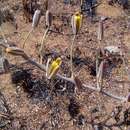en
names in breadcrumbs


Albuca is a genus of flowering plants in the family Asparagaceae, subfamily Scilloideae.[2] The genus is distributed mainly in southern and eastern Africa, with some species occurring in northern Africa and the Arabian Peninsula.[3] Plants of the genus are known commonly as slime lilies.[4]
These are perennial herbs growing from bulbs. The stem is sheathed in leaves with linear to strap-shaped blades.[5] They can be 8 centimeters to well over one meter long and are flat or keeled. They are generally fleshy and sappy with a mucilaginous juice that inspired the common name "slime lilies".[6] The flowers of some species are scented, especially at night. They are borne in racemes, usually slender, but flat-topped in some species. The flowers may be on stiff, or slender, nodding stalks,[6] held erect or drooping. The six tepals are white to yellow and each has a green or brown stripe down the center. The outer three tepals spread open, while the inner three are connivent, curving inward so that the tips meet.[5] There are six stamens, which have wings at the bases that wrap around the ovary at the center of the flower. Some species have six fertile stamens, and in others the outer stamens are staminodes which do not produce pollen.[4] The fruit is a rounded or oval three-lobed capsule containing shiny black seeds.[5]
The three inner tepals can be closed firmly, raising the question of how pollinators might reach the stigma inside to deposit pollen.[4] In a study of the interaction between pollinators and Albuca flowers, leafcutter bees were observed prying open the tepals and squeezing through to obtain the nectar inside. In the process, they left pollen on the tips of the tepals, where it absorbed fluid, germinated, and fertilized ovules. This was the first known case of flower petals performing the function of the stigma.[4] The only thing even distantly similar is Lacandonia where the pollen tube travels down the stamen, across the base and up the pistils to pollinate from below.
The genus is circumscribed in two ways. The traditional genus Albuca is a monophyletic group of about 60 known species,[7] and possibly about 100 in total.[8] Other authorities have considered Albuca in a wider sense, including such genera as Stellarioides, Coilonox, Trimelopter, and Battandiera, for a total of 110 to 180 very heterogeneous species.[3] All of these genera, including Albuca, have also been lumped together in Ornithogalum at times, but molecular phylogenetics studies support their separation.[8]
The genus, defined broadly, contains about 160 accepted species, according to the World Checklist of Selected Plant Families as of May 2018.[1]
The most popular species is Albuca nelsonii, which is evergreen and not frost-hardy. Such species are best suited to temperate areas, but can be grown in a conservatory or greenhouse, or in a sheltered position if light frosts might occur. However, some other species from alpine or Karoo-like areas are fairly frost-resistant and may be deciduous, and accordingly can stand a good deal of frost once established. Some in fact are winter-flowering.[11] As a rule they do well in full sun in light, free-draining soil. Propagate from offsets or seed.
Albuca is a genus of flowering plants in the family Asparagaceae, subfamily Scilloideae. The genus is distributed mainly in southern and eastern Africa, with some species occurring in northern Africa and the Arabian Peninsula. Plants of the genus are known commonly as slime lilies.